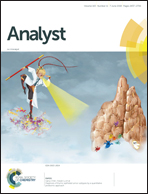Diagnosis of thymic epithelial tumor subtypes by a quantitative proteomic approach†
Abstract
The histological typing of thymic epithelial tumours (TETs) still remains a challenge for surgical pathologists, especially when encountering borderline cases mainly focused on spindle cell types (including type A, atypical type A (aA), AB, and B3). A systematic proteomics analysis of TETs was performed using isobaric tags for relative and absolute quantification (iTRAQ) labeling coupled with two-dimensional liquid chromatography-tandem mass spectrometry (2D-LC-MS/MS). In total, 6479 and 6305 proteins were identified and quantified, respectively. After Gene Ontology (GO) annotation and Ingenuity Pathway Analysis (IPA), six differentially expressed proteins were validated by tissue microarray or multiple reaction monitoring (MRM) quantification. ABCE1 and CLIC2 are promising to be diagnostic candidate biomarkers in thymic carcinomas (TCs). CHD1L was up-regulated in type AB and type B thymomas compared with type A thymoma. Both CLIC2 and MAP7 were negatively detected in type B1 and B2 thymomas. SMAD4 was overexpressed in type aA thymomas and TCs. CDC42 was significantly down-regulated in type B2 thymomas compared with other subtypes. Six novel candidate biomarkers were found to be useful in differentiating subtypes of TETs. SMAD4 may play a specific role in tumorigenesis and the development of aA thymomas and thymic carcinomas.



 Please wait while we load your content...
Please wait while we load your content...